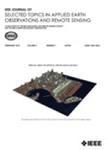版权所有:内蒙古大学图书馆 技术提供:维普资讯• 智图
内蒙古自治区呼和浩特市赛罕区大学西街235号 邮编: 010021

作者机构:Chinese Acad Sci Inst Geodesy & Geophys State Key Lab Geodesy & Earths Dynam Wuhan 430077 Hubei Peoples R China Univ Chinese Acad Sci Beijing 100049 Peoples R China Nanjing Univ Posts & Telecommun Dept Surveying & Geoinformat Nanjing 210023 Jiangsu Peoples R China
出 版 物:《IEEE JOURNAL OF SELECTED TOPICS IN APPLIED EARTH OBSERVATIONS AND REMOTE SENSING》 (IEEE应用地球观测与遥感选题杂志)
年 卷 期:2019年第12卷第9期
页 面:3458-3469页
核心收录:
学科分类:0808[工学-电气工程] 1002[医学-临床医学] 08[工学] 0705[理学-地理学] 0816[工学-测绘科学与技术]
基 金:National Natural Science Foundation of China [41590854, 41501497, 41431070] State Key Laboratory of Geodesy and Earth's Dynamics (Institute of Geodesy and Geophysics, CAS) [SKLGED2018-5-2-E]
主 题:Lunar-based synthetic aperture radar (LB-SAR) repeat-track interferometry (RTI) spatial coverage spatiotemporal baseline
摘 要:Lunar-based synthetic aperture radar repeat-track interferometry (LB-SAR RTI) is expected to play a significant role in addressing science issues pertaining to Earth dynamics because of its large-scale, long-term, and stable Earth observation (EO) ability. The distribution of the spatiotemporal baseline and effective spatial coverage are of great importance in the observation mode design and data acquisitions plan of LB-SAR RTI. Here, we describe the observation geometry and present the calculation method of the spatiotemporal baseline and effective spatial coverage of LB-SAR RTI. Using the Jet Propulsion Laboratory DE430 ephemeris, the results show that, first, the 1, 26, and 27 repeat cycles temporal baselines have the highest number of effective interferometric combinations, accounting for 50% of the effective observations;second, the optimal temporal baselines of LB-SAR RTI for large-scale EO are 26 and 27 repeat cycles, and the effective spatial coverage could reach up to 360 degrees x 40 degrees (longitudexlatitude) in one day;and third, LB-SAR RTI can be used to observe the Earth s surface between latitudes 80 degrees N and 80 degrees S with different frequencies of observation that reach a maximum at latitudes 40 degrees N and 40 degrees S and decrease gradually toward the polar and equator regions. The lunar-based observation plan should take into account the initial observation time, temporal baseline, and effective spatial coverage.